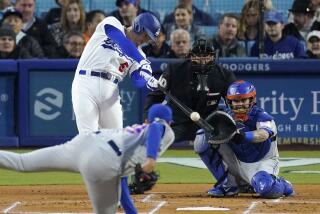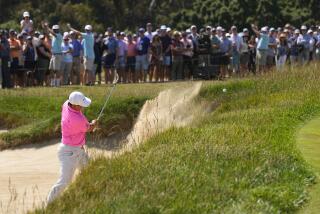Tiger on the perfect swing
- Share via
After I won the 1997 Masters with a record score of 270, 18 under par, I wasted no time before celebrating. I partied with my buddies, traveled a little and generally had a great time.
A week or so later, after the elation had started to die down, I sat down to watch a tape of the tournament -- to see if there was some flaw I might work on.
I didn’t see one flaw. I saw about 10.
I had struck the ball great that week, but by my standard, I had gotten away with murder. My clubshaft was across the line at the top of the backswing and my clubface was closed. My swing plane was too upright. I liked my ball flight, but I was hitting the ball farther with my irons than I should have been because I was delofting the clubface through impact.
The more I thought about it, the more I realized I didn’t like how my swing felt either.
Even before the tape ended, I committed myself to making some big changes in my swing.
That overhaul -- done with the help of my coach, Butch Harmon -- took more than a year. First my full swing started to look better. Then the ball started to behave better. Finally my swing started to feel right.
The point: The golf swing will always be a work in progress. The goal is to have a swing that is mechanically sound, repeatable, works with every club in your set and holds up under pressure.
ONE GRIP FOR ALL SHOTS
The grip is the cornerstone of the swing; it’s related to almost every element of the swing itself, including path, clubface position and posture.
My grip has evolved over the years. Today I keep my left hand in a fairly neutral position, with 2 1/2 knuckles showing at address. That’s a position I know will suit most every golfer.
The handle of the club runs diagonally across the base of the fingers on my left hand, from the base of the forefinger to a point atop the callus pad below my little finger. That provides the best combination of sensitivity and control.
I avoid placing the handle too far toward the palm of my open hand. I’ll lose clubhead speed and sensitivity.
When the left-hand grip is complete and I lower the club into the address position, my thumb should be positioned to the right of center on the handle, and the “V” formed by my right thumb and forefinger should point just outside my right ear.
The right-hand grip is similar to that of the left. The main difference: The club is placed more along the fingers. The handle should run from the middle portion of your right index finger to the base of your pinkie. This activates your right hand so it can supply speed on the downswing.
WHY I INTERLOCK
As a boy I was taught the interlocking grip, the little finger of my right hand laced between the forefinger and middle finger of my left hand. That’s how Jack Nicklaus, my idol, did it, and I copied him. It gives me the feeling that my hands can’t separate during the swing.
THE FINISHED PRODUCT
My complete grip provides a sense of snugness and unity between the two hands. If you don’t have that sensation, practice gripping and regripping the club.
You should hold the club lightly enough to allow plenty of wrist freedom and to have some feel, but firmly enough to maintain control of the club throughout the swing. And keep your grip pressure steady.
POSTURE: SET UP LIKE AN ATHLETE
Golf is like any sport that requires movement. You need to be in an athletically ready position so you can respond to movement quickly, smoothly and without losing your balance. The key to good posture is matching up your torso and lower body, so one can react to the other throughout the swing.
I want just enough bend in my knees to feel balanced and ready for action. I have a sense of being light on my feet. My weight is distributed evenly from heel to toe, and my hips and shoulders are ready to rotate freely with full cooperation from my legs and feet.
DISTANCE FROM THE BALL
Standing the right distance from the ball at address is vital. If I’m too close or too far, I’m forced to make all sorts of anatomical adjustments in order to compensate -- and I won’t compensate very well.
The signs that I’m standing the correct distance away are clear: My arms are hanging comfortably, just a shade outside vertical. My knees are flexed slightly, I’m bent over at the hips comfortably but not too far, and my weight is evenly positioned between my heels and toes.
BEGINNING THE BACKSWING
Start the full swing by setting the club into motion correctly. Notice I said the club, not your body.
The reason you’ve worked hard at positioning your body is so it can transport the club on the proper path and plane throughout the swing.
START THE CLUB “ON LINE.” Midway through the backswing, the club should be parallel with your stance line. You get it there by swinging the club back with your shoulders, arms and hands working together smoothly.
DON’T LET THE CLUB STRAY INSIDE. If the club moves too far to the inside midway through the backswing, the shaft aiming to the right of my target, you’re forced to make compensations to get the club back on track.
THE MAGIC TRIANGLE
The longer and wider you make your backswing, the more time you give yourself to accumulate speed and power on the downswing. A big shoulder turn is responsible for part of that, but your arms play a big role, too.
Think: wide at the top. I push my left arm away from my head as far as I can, and my right arm goes along with it. My two arms and elbows form a triangle that helps keep the clubface square and the club on line.
LET GRAVITY RULE
The faster you swing the club through impact, the farther the ball goes. That’s a simple equation, but obtaining speed and power on the downswing is easier said than done.
A common problem is rushing the downswing -- letting loose with everything you have the moment the backswing is complete. The result: The shoulders outrace the arms, the arms outrace the hands and the hands outrace the club. All that speed is expended too soon and the clubhead is actually losing speed as it strikes the ball, when it should be accelerating.
I start the downswing by shifting my weight easily back to my left side, then letting my arms “fall” downward in front of my chest. I don’t want my shoulders unwinding so fast that they get way ahead of my arms.
By giving my arms a little head start, they work in concert with my shoulders to create a real package of power coming into the ball.
More to Read
Go beyond the scoreboard
Get the latest on L.A.'s teams in the daily Sports Report newsletter.
You may occasionally receive promotional content from the Los Angeles Times.










